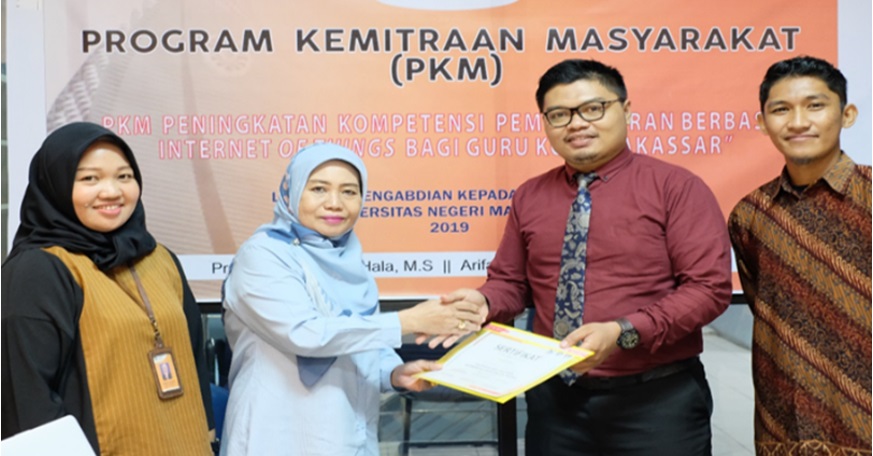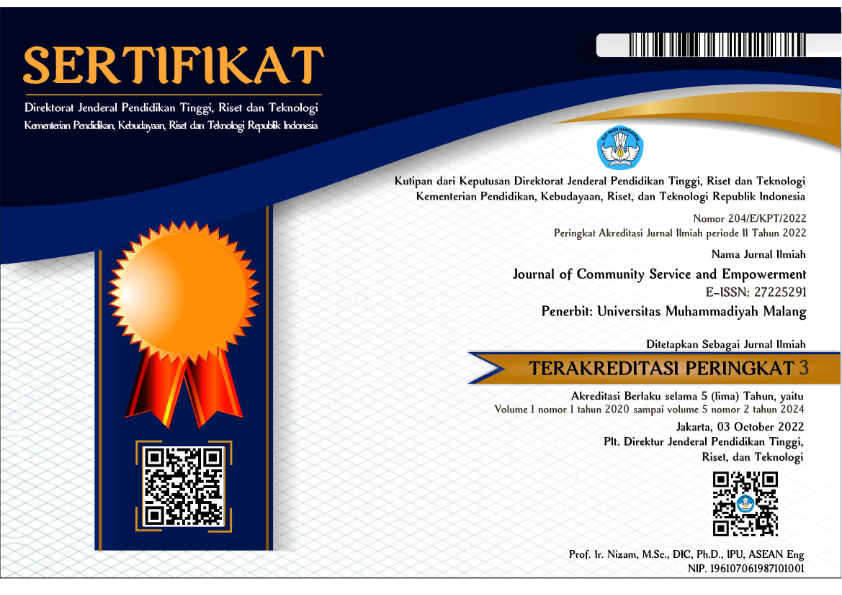Improving teachers’ competence on the use of internet of things for teachers in the city of Makassar
DOI:
https://doi.org/10.22219/jcse.v1i3.12420Keywords:
Digital literacy, Education improvement, Internet of Things, Teacher competenciesAbstract
Internet of Things (IoT) is part of digital literacy that its function is undeniable when people are today obsessed more to social media and gadgets. IoT is greatly potential to support education field, especially in facilitating teachers. However, with all functions it has, IoT is not well mastered by many teachers in the city of Makassar. The issue is mainly because teachers are not well literate to IT. Therefore, it is significant to provide teachers with some trainings or workshops. Thus, this community service is projected to improve teachers’ competence in the use of IoT so that they will be life-long learners in the future. The ability to be life-long learner is one of the indicators to Sustainable Development Goals (SDGs). This community service has resulted in several outputs, they are: 1) teachers are equipped with the ability to use IoT and e-learning software, 2) the scoring results reveal that this community service has the average score of 4,67 (good criteria).
Downloads
References
Abbas, Z., & Yoon, W. (2015). A survey on energy conserving mechanisms for the Internet of Things: Wireless networking aspects. Sensors, 15(10), 24818–24847. https://doi.org/10.3390/s151024818
Abd-Ali, R. S., Radhi, S. A., & Rasool, Z. I. (2020). A survey: the role of the internet of things in the development of education. Indonesian Journal of Electrical Engineering and Computer Science, 19(1), 215. https://doi.org/10.11591/ijeecs.v19.i1.pp215-221
AjazMoharkan, Z., Choudhury, T., Gupta, S. C., & Raj, G. (2017). Internet of Things and its applications in E-learning. 2017 3rd International Conference on Computational Intelligence & Communication Technology (CICT), 1–5. https://doi.org/10.1109/CIACT.2017.7977333
Aldowah, H., Ul Rehman, S., Ghazal, S., & Naufal Umar, I. (2017). Internet of things in higher education: A study on future learning. Journal of Physics: Conference Series, 892, 012017. https://doi.org/10.1088/1742-6596/892/1/012017
Al-Emran, M., Malik, S. I., & Al-Kabi, M. N. (2020). A Survey of Internet of Things (IoT) in education: Opportunities and challenges. In Studies in Computational Intelligence (pp. 197–209). Springer. https://doi.org/10.1007/978-3-030-24513-9_12
Atmojo, A. E. P., & Nugroho, A. (2020). EFL classes must go online! Teaching activities and challenges during COVID-19 pandemic in Indonesia. Register Journal, 13(1), 49–76. https://doi.org/10.18326/rgt.v13i1.49-76
Atzori, L., Iera, A., & Morabito, G. (2017). Understanding the Internet of Things: definition, potentials, and societal role of a fast evolving paradigm. Ad Hoc Networks, 56, 122–140. https://doi.org/10.1016/j.adhoc.2016.12.004
Blue, E., & Tirotta, R. (2011). The benefits & drawbacks of integrating cloud computing and interactive whiteboards in teacher preparation. TechTrends, 55(3), 31–39. https://doi.org/10.1007/s11528-011-0495-7
Fuada, S., Ichsan, I. N., Pratama, H. P., Putri, D. I. H., Suranegara, G. M., Setyowati, E., & Fauzi, A. (2020). Workshop Internet-of-Things untuk guru dan siswa sekolah menengah di Purwakarta, Jawa Barat, guna menunjang kompetensi Era Industri 4.0. J-ABDIPAMAS (Jurnal Pengabdian Kepada Masyarakat), 4(2), 39. https://doi.org/10.30734/j-abdipamas.v4i2.938
Gómez, J., Huete, J. F., Hoyos, O., Perez, L., & Grigori, D. (2013). Interaction system based on Internet of Things as support for education. Procedia Computer Science, 21, 132–139. https://doi.org/10.1016/j.procs.2013.09.019
Gubbi, J., Buyya, R., Marusic, S., & Palaniswami, M. (2013). Internet of Things (IoT): A vision, architectural elements, and future directions. Future Generation Computer Systems, 29(7), 1645–1660. https://doi.org/10.1016/j.future.2013.01.010
Kassab, M., DeFranco, J., & Laplante, P. (2020). A systematic literature review on Internet of things in education: Benefits and challenges. Journal of Computer Assisted Learning, 36(2), 115–127. https://doi.org/10.1111/jcal.12383
Khan, R., Khan, S. U., Zaheer, R., & Khan, S. (2012). Future internet: The Internet of Things architecture, possible applications and key challenges. 2012 10th International Conference on Frontiers of Information Technology, 257–260. https://doi.org/10.1109/FIT.2012.53
Madakam, S., Ramaswamy, R., & Tripathi, S. (2015). Internet of Things (IoT): A literature review. Journal of Computer and Communications, 03(05), 164–173. https://doi.org/10.4236/jcc.2015.35021
Ng, I. C. L., & Wakenshaw, S. Y. L. (2017). The Internet-of-Things: Review and research directions. International Journal of Research in Marketing, 34(1), 3–21. https://doi.org/10.1016/j.ijresmar.2016.11.003
Ningsih, N., Sutanto, T., & Harianto, H. (2021). Pelatihan Internet of Things untuk guru SMA Tanwir Surabaya dengan menerapkan aturan social distancing pada SMA Tanwir. Jurnal Karya Abdi Masyarakat, 4(3), 687–695. https://doi.org/10.22437/jkam.v4i3.11659
Pei, X. L., Wang, X., Wang, Y. F., & Li, M. K. (2013). Internet of Things based education: Definition, benefits, and challenges. Applied Mechanics and Materials, 411-414, 2947–2951. https://doi.org/10.4028/www.scientific.net/AMM.411-414.2947
Razzaque, A., & Hamdan, A. (2020). Internet of Things for learning styles and learning outcomes improve e-learning: A review of literature. Proceedings of the International Conference on Artificial Intelligence and Computer Vision (AICV2020), 783–791. https://doi.org/10.1007/978-3-030-44289-7_73
Rizal, R., Setiawan, W., & Rusdiana, D. (2019). Digital literacy of preservice science teacher. Journal of Physics: Conference Series, 1157, 022058. https://doi.org/10.1088/1742-6596/1157/2/022058
Saddhono, K., Mulyaningsih, I., Sudarsana, I. K., & Manurung, R. T. (2019). Indonesian language teachers’ attitudes toward ICT utilization in learning for elementary school in Surakarta. Journal of Physics: Conference Series, 1254, 012062. https://doi.org/10.1088/1742-6596/1254/1/012062
Setiawan, H. S. (2018). Pelatihan guru dalam penggunaan Internet of Things pada Madrasah Darussa’adah. E-Dimas: Jurnal Pengabdian Kepada Masyarakat, 9(2), 167–176. https://doi.org/10.26877/e-dimas.v9i2.1554
Syakroni, A., Zamroni, Muali, C., Baharun, H., Sunarto, M. Z., Musthofa, B., & Wijaya, M. (2019). Motivation and learning outcomes through the Internet of Things; Learning in pesantren. Journal of Physics: Conference Series, 1363, 012084. https://doi.org/10.1088/1742-6596/1363/1/012084
Verma, P., & Sood, S. K. (2018). Internet of Things-based student performance evaluation framework. Behaviour & Information Technology, 37(2), 102–119. https://doi.org/10.1080/0144929X.2017.1407824
Want, R., Schilit, B. N., & Jenson, S. (2015). Enabling the Internet of Things. Computer, 48(1), 28–35. https://doi.org/10.1109/MC.2015.12
Whitmore, A., Agarwal, A., & Da Xu, L. (2015). The Internet of Things—A survey of topics and trends. Information Systems Frontiers, 17(2), 261–274. https://doi.org/10.1007/s10796-014-9489-2
Yeo, K. S., Chian, M. C., Wee Ng, T. C., & Tuan, D. A. (2014). Internet of Things: Trends, challenges and applications. 2014 International Symposium on Integrated Circuits (ISIC), 568–571. https://doi.org/10.1109/ISICIR.2014.7029523
Zhang, Y. (2011). Technology framework of the Internet of Things and its application. 2011 International Conference on Electrical and Control Engineering, 4109–4112. https://doi.org/10.1109/ICECENG.2011.6057290
Zhong, C.-L., & Li, Y. (2020). Internet of things sensors assisted physical activity recognition and health monitoring of college students. Measurement, 159, 107774. https://doi.org/10.1016/j.measurement.2020.107774

Downloads
Published
How to Cite
Issue
Section
License
Copyright (c) 2020 Yusminah Hala, Arifah Novia Arifin

This work is licensed under a Creative Commons Attribution-ShareAlike 4.0 International License.












